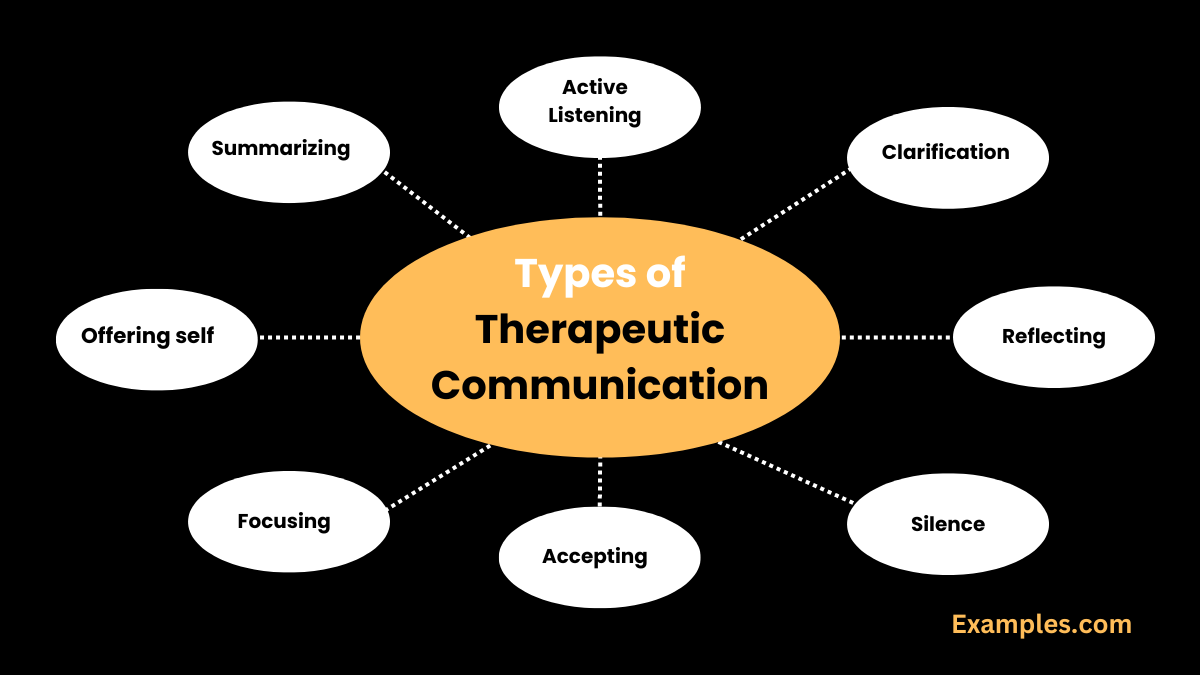Types of Therapeutic Communication – Examples, Types
Unlock the nuances of healing connections with our comprehensive guide on Types of Therapeutic Communication. Delve into real-life scenarios and expert tips for effective interpersonal engagement. Elevate your communication skills with practical insights and meaningful communication examples. Foster empathy, understanding, and resilience in your interactions, making every connection a therapeutic opportunity for growth and support. Learn how therapeutic communication transforms dialogues, promoting emotional well-being and creating lasting connections. Communication examples included for a richer understanding.
Types of Therapeutic Communication

Unlock the diverse strategies encompassing types of therapeutic communication to foster meaningful connections. Effective communication skills play a pivotal role in various contexts, and therapeutic communication goes beyond conventional dialogues. Dive into the intricacies of these communication styles.
Active Listening Therapeutic Communication
Active listening in Therapeutic Communication is a fundamental skill that involves fully engaging with and understanding a speaker’s message. Practitioners employ focused attention, reflecting, paraphrasing, and summarizing to demonstrate genuine interest and empathy. By fostering a nonjudgmental environment and offering verbal and nonverbal cues, active listening allows individuals to express their thoughts and emotions freely. This encourages trust, strengthens therapeutic alliances, and promotes the client’s overall well-being within the context of supportive and empathetic communication.
Clarification Therapeutic Communication
Clarification in Therapeutic Communication is a crucial technique employed to ensure mutual understanding between communicators. It involves seeking additional information, confirming understanding, or resolving potential misunderstandings. This active listening strategy promotes clarity, validates the speaker’s feelings, and encourages open dialogue. By seeking clarification, healthcare professionals, counselors, and other practitioners can enhance the therapeutic relationship, address uncertainties, and provide more accurate and personalized support to those in need, fostering a foundation for effective communication and healing.
Reflecting Therapeutic Communication
Reflecting in Therapeutic Communication involves mirroring or paraphrasing a client’s thoughts and feelings to convey understanding. This technique enhances empathy and encourages clients to explore their emotions further. By restating content or emotions, therapists validate the client’s experiences, fostering a sense of being heard. Reflecting not only reinforces the therapeutic alliance but also aids in clarifying and deepening the client’s self-awareness, promoting a more profound and constructive therapeutic process.
Silence Therapeutic Communication
Silence in Therapeutic Communication is a powerful and intentional pause employed to facilitate deeper understanding and connection between the communicator and the recipient. It allows individuals to reflect on their thoughts, process emotions, and create a safe space for open expression. Silence can convey empathy, respect, and patience, fostering an environment where individuals feel heard and valued. Skilled use of silence enhances the therapeutic process, encouraging introspection and promoting a more profound connection between communicators.
Accepting Therapeutic Communication
Acceptance in Therapeutic Communication involves embracing individuals without judgment or criticism, creating a safe and supportive environment for self-disclosure. Therapists express empathy, validate emotions, and acknowledge the client’s experiences, fostering trust. By avoiding condemnation, they encourage open dialogue, allowing clients to explore their feelings freely. Acceptance is a cornerstone, providing a foundation for personal growth, building rapport, and facilitating the healing process within therapeutic relationships.
Focusing Therapeutic Communication
Focusing in Therapeutic Communication involves honing attention on the client’s specific concerns, emotions, or experiences. This technique enhances the depth of interpersonal connections, allowing the practitioner to understand and respond effectively. By actively concentrating on the client’s verbal and nonverbal cues, the communicator demonstrates empathy and creates a safe space for the individual to express their feelings. Focusing promotes a client-centered approach, facilitating a more profound and meaningful therapeutic exchange.
Offering self Therapeutic Communication
Offering oneself in Therapeutic Communication involves genuine, empathetic, and nonjudgmental engagement. This approach encourages open expression and trust-building between the communicator and the recipient. By authentically sharing emotions, experiences, and vulnerabilities, the communicator creates a safe space for the other person to reciprocate, fostering a deeper therapeutic connection. This practice enhances the therapeutic relationship, allowing individuals to explore their feelings, confront challenges, and work towards personal growth within a supportive and understanding environment.
Summarizing Therapeutic Communication
Summarizing in Therapeutic Communication involves succinctly capturing and articulating key points or emotions expressed during an interaction. This skill helps individuals consolidate information, validate feelings, and ensure mutual understanding. Whether in counseling sessions, healthcare settings, or everyday conversations, effective summarization enhances communication by demonstrating active listening and facilitating focused discussions. It promotes clarity, reinforces rapport, and supports the therapeutic process by encapsulating the essence of the communicated content.
Confrontation Therapeutic Communication
Confrontation in Therapeutic Communication involves skillfully addressing discrepancies or challenging behaviors in a supportive manner. This approach encourages individuals to explore conflicting thoughts or actions, promoting self-awareness and growth. Rather than instigating conflict, it aims to foster understanding and resolution. Skilled therapists use confrontation judiciously, creating a safe space for clients to confront their own issues and facilitating a constructive dialogue that contributes to therapeutic progress and insight.
Restating Therapeutic Communication
Restating in Therapeutic Communication involves paraphrasing or summarizing a message to ensure understanding and convey empathy. This technique fosters active listening, validating the speaker’s feelings and thoughts. By restating, the listener demonstrates engagement, promotes clarity, and encourages further exploration of emotions. In therapeutic settings, restating enhances communication by affirming the individual’s experiences, building trust, and facilitating a collaborative and supportive environment for open dialogue and emotional expression.
Exploring Therapeutic Communication
Exploring Therapeutic Communication involves delving into various techniques and approaches that facilitate empathetic and supportive interactions. Professionals navigate verbal and nonverbal channels, adapting strategies like active listening, open-ended questioning, and paraphrasing to create a safe space for expression. By understanding the nuances of communication styles, exploring body language, and mastering diverse therapeutic approaches, individuals can enhance their ability to connect, understand, and promote healing within therapeutic contexts.
Touch Therapeutic Communication
Touch in Therapeutic Communication serves as a powerful nonverbal tool, conveying empathy, comfort, and support. Carefully applied, it can enhance the therapeutic alliance, promoting trust and emotional connection between the communicator and the recipient. Examples include a comforting hand on the shoulder to express sympathy or a reassuring touch during moments of distress. However, it’s crucial to respect individual boundaries and cultural differences to ensure touch is consensual and therapeutic within the context of the relationship.
Giving Recognition Therapeutic Communication
Giving Recognition in Therapeutic Communication involves acknowledging and validating a person’s thoughts, feelings, or experiences. It fosters a supportive environment by affirming their emotions and experiences, promoting a sense of understanding and empathy. This positive affirmation helps build trust and rapport between individuals, facilitating effective communication in therapeutic settings. Recognizing and validating one’s emotions contribute to the therapeutic process, creating a foundation for meaningful interactions and promoting emotional well-being.
Paraphrasing Therapeutic Communication
Paraphrasing in Therapeutic Communication involves rephrasing or restating a client’s expressed thoughts or feelings to demonstrate understanding and promote a deeper connection. By summarizing the client’s words in a slightly different way, the therapist validates the client’s experiences and encourages further exploration of emotions. This skill fosters trust, enhances communication, and aids in the therapeutic process by affirming the client’s feelings while facilitating clearer expression and reflection.
General Leads Therapeutic Communication
General leads in Therapeutic Communication refer to open-ended statements or questions that encourage patients to express their thoughts and feelings. These prompts, such as “Tell me more about that,” or “How are you feeling today?” guide the conversation without steering it in a specific direction. By using general leads, healthcare professionals create an atmosphere of openness, fostering effective communication and allowing patients to share their concerns and experiences more freely, ultimately enhancing the therapeutic relationship.
Giving Broad Openings Therapeutic Communication
Giving Broad Openings in Therapeutic Communication involves inviting the client to share their thoughts openly, fostering a comfortable space for expression. By using phrases like “Tell me what’s on your mind” or “How would you like to begin today?” the therapist encourages the client to initiate conversation, promoting a sense of control and trust. This technique enhances the therapeutic relationship and allows for a more comprehensive exploration of the client’s feelings and concerns.
Offering Hope Therapeutic Communication
Offering Hope in Therapeutic Communication involves providing compassionate support and fostering a positive outlook for individuals facing challenges. It entails empathetic listening, encouraging words, and instilling a sense of optimism. Through this approach, therapists inspire resilience, instill confidence, and illuminate the potential for positive change. By offering hope, they create a therapeutic space where individuals feel understood and motivated to navigate their struggles with newfound strength and determination.
Voicing Doubt Therapeutic Communication
Voicing Doubt in Therapeutic Communication involves expressing uncertainty or questioning in a supportive manner. This technique allows a counselor or therapist to gently challenge a client’s thoughts or beliefs, encouraging reflection and deeper exploration. By articulating doubt empathetically, the professional creates a safe space for the client to reconsider their perspectives, fostering a collaborative and introspective therapeutic process. This method can promote self-awareness and facilitate positive change in the client’s mindset.
Addressing Emotions Therapeutic Communication
Addressing Emotions in Therapeutic Communication involves acknowledging and validating a person’s feelings. By creating a supportive environment, practitioners can help individuals express and explore their emotions openly. This process fosters trust and encourages emotional growth, paving the way for effective therapeutic outcomes. The act of addressing emotions allows individuals to feel heard and understood, promoting a deeper connection between the communicator and the recipient, facilitating healing and personal development.
In conclusion, mastering various types of therapeutic communication is essential for effective and compassionate interpersonal interactions. Whether through oral, nonverbal, written, or visual means, these techniques empower professionals to connect empathetically and supportively with individuals across diverse contexts. By understanding and applying these communication methods, individuals can foster healing, encourage self-expression, and build meaningful connections within therapeutic relationships.



